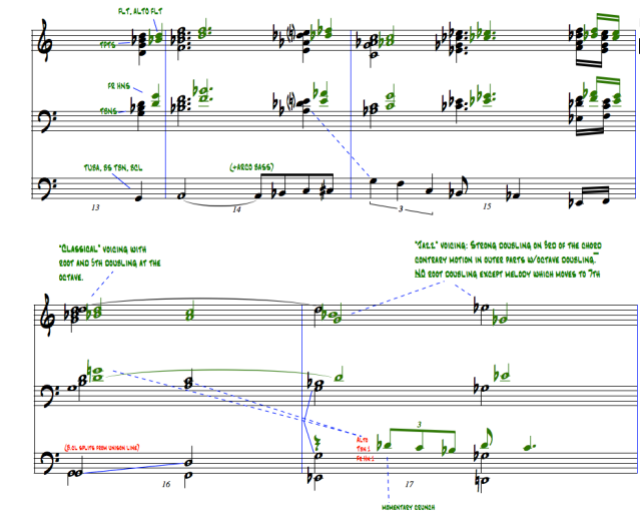Repost: Blues for Pablo: True to Form
Yes, it’s another retread…the following is a popular post from my other blog:
What do you call this…something like “orchestrational and harmonic gestural writing”, or “tonal consequence”, or even “temporal textural tautological antiphony”?…maybe you just mean “music”.
“Blues for Pablo”–True to Form
Posted on October 8, 2011 by Scott Healy
View the original article at professorscosco.com.
Blues for Pablo is to me the best piece of music on the great Miles Davis/Gil Evans 1958 record Miles Ahead (also titled Miles +19.) It’s a rich and detailed work. Gil’s techniques–transparent orchestration, use of instruments such as alto flute, french horns, tuba and muted brass, inter-choir unison doublings, cross-doubling, no piano, non-traditional yet balanced voicings–all have become the meat and potatoes of modern jazz large ensemble writing.
But this business of writing a short phrase that has a beginning and an end, that encapsulates the tonal vibe and moves the piece forward, was what struck me the most when I got into examining Blues for Pablo. Consider the following passage, M. 13-17, audio excerpt and score reduction below:
[soundcloud url=”http://api.soundcloud.com/tracks/25091319″ params=”color=9c4d17&auto_play=false&show_artwork=true” width=” 100%” height=”166″ iframe=”true” /]

These four short bars, M. 13-17 of “Blues for Pablo,” propel the piece forward by creating harmonic and textural tension, then resolving.
Gil evokes harmonic tension and resolution through the phrase in two ways:
- Changing intervalic tension through melody and register: The first chord, a straight G minor triad is thrown into turmoil by the low melodic unison beginning on A. This results in a minor 9th between the low A and the Bbmaj (or perhaps Gmi7) triad above. On the fourth beat is a similar dissonance, a low C passing tone against a Dbmin triad, this time a little less striking due to its quick movement up to the root. Then the melody rises up to a G in the middle of the bass clef, creating a momentary rub again with the Ab (the 3rd of the F minor chord) on the downbeat of M. 15 (an appoggiatura, an on the beat dissonance approached with a leap and resolved by a step.) In the next bar the low melody dips down low, but this time lands on the root on the downbeat of M. 16. Consonance. The flutes and two trombones move down in thirds to the Ebmaj7 on the downbeat of 17, again the low melody is on the root–interestingly the bass clarinet splits off and plays the 3rd of the chord forming a rich, consonant 10th in the two lowest voices (see the next paragraph.) On beat 2 we hear the intensely cool blues riff, which although it rubs against the major 7th chord, its coolness is consonant–same with the Db on beat 3 against the D7b9 chord. The overall chord progression starts with the Spanish parallel minor chords, and ends with a minor blues cadence: bIVmaj7-V7(b9)-i.
- Altering the doubling and the ensemble voicing style. Within the span of four measures Gil moves methodically from a brilliant and dissonant “classical” sound to a more transparent, rich and calm “jazz” sound. Cross-doubling, unisons and octave doubling are used in different ways. The pickup in M. 13 and the first beat of M. 14 are triads doubled at the octave, the downbeat of M. 15 is a close-voiced Fmin9 chord again doubled at the octave; the Dbmin on beat 3 is similarly octave doubled. The tension starts to break with the pickup to M. 16, contrary motion in the outer voices enhances the melodic ensemble movement. When the thirds split off and move down in M. 16 the texture breaks, the French horn cross-doubled with a trombone hold the D through the first two beats of M. 17, and the bass clarinet jumps up and doubles the third trombone on the G as the top of the tenth in the bass register. In the context of the rich Ebmaj7 and D7b9 chords in the cross-doubled notes enhance the “power tone” 3rds moving down–and the blues riff is strong yet transparent as a result of unison doubling. Cross-doubling the flutes with the trumpets and the 2nd French horn with the 1st trombone in M. 13-16 supports the melody and creates a transparent ensemble texture. The “classical” voicing style in these measures, i.e., 5ths and roots doubled, makes the ensemble ring with reinforced perfect intervals, and the parallel motion is distinctly “non-jazzy.” Then Gil shifts gears and lets the air out of it, and beginning in M. 16 and through M. 17, the cross-doubled blues riff, the spread spacing with no doubled roots and no 5ths, fits right in and brings us back to the jazz realm.






No Response
Leave us a comment
No comment posted yet.